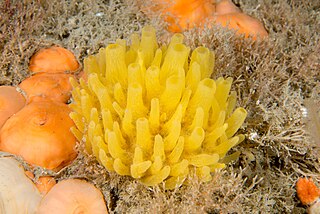
Cliona celata, occasionally called the boring sponge, is a species of demosponge belonging the family Clionaidae. It is found worldwide. This sponge bores round holes up to 5 millimetres (0.20 in) in diameter in limestone or the shells of molluscs, especially oysters. The sponge itself is often visible as a rather featureless yellow or orange lump at the bottom of the hole.

Polymastia is a genus of sea sponges containing about 30 species. These are small to large encrusting or dome-shaped sponges with a smooth surface having many teat-shaped projections (papillae). In areas of strong wave action, this genus does not grow the teat structures, but instead grows in a corrugated form.

Halichondria panicea, commonly known as the breadcrumb sponge, is a species of sea sponge belonging to the family Halichondriidae. This is an abundant sponge of coastal areas of the North Atlantic and the Mediterranean Sea ranging from the intertidal zone to a recorded depth of over 550 m. It is also found in the intertidal zone of the coast of the northern part of the North Island of New Zealand. It is very tolerant of a wide range of coastal habitats, including strong currents, high salinity and exposure to powerful wave action. Its only requirement is a rocky substrate which can include small cobbles.

Tetillidae is a family of marine sponges. Tetillids are more or less spherical sponges which are found commonly in all marine habitats at all depths throughout the world. They are especially common in sedimented habitats. Over a hundred species have been described in ten genera.

Homosclerophorida is an order of marine sponges. It is the only order in the monotypic class Homoscleromorpha. The order is composed of two families: Plakinidae and Oscarellidae.

Ircinia strobilina is a species of sponge in the family Irciniidae. It is grey or shiny black in colour, with spiny structures (conules) dotting the surface. The spiny structures are interconnected by ridges, though not arranged in an orderly lattice. This species is globular and massive in shape, but usually no more than 0.3 metres (1 ft) across. I. strobilina is lobed and spherical and has a tough consistency. The large excurrent pores are located in depressions at the top of the sponge. Many smaller incurrent pores are scattered across the surface, more densely at the sides.

Clionaidae is a family of ectoparasitic demosponges which are found worldwide. This group of sponges are well known for boring holes in calcareous material such as mollusc shells and coral skeletons, using both chemical and mechanical processes.

Amphimedon compressa, the erect rope sponge, red tree sponge, red tubular sponge, or red sponge is a demosponge found in southern Florida, the Caribbean Sea, and the Bahamas. It can be deep red, orange, brown, or black.
Homaxinella is a genus of sea sponges in the family Suberitidae. The type species is Homaxinella balfourensis.

Umimayanthus parasiticus, commonly known as the sponge zoanthid, is a species of coral in the order Zoantharia which grows symbiotically on several species of sponge. It is found in shallow waters in the Caribbean Sea and the Gulf of Mexico.
Cliona delitrix is a species of burrowing demosponge belonging to the family Clionaidae. It is found in shallow water in the Caribbean Sea and the Gulf of Mexico.
Agelas schmidti, commonly known as the brown tubular sponge, is a species of demosponge. It occurs at moderate depths in the Gulf of Mexico and the Caribbean Sea and often has a colonial coral growing over the surface. The type locality is Puerto Rico.
Neofibularia nolitangere, commonly known as the touch-me-not sponge, is a species of sea sponge in the family Biemnidae. It is found in shallow waters in the Western Atlantic Ocean and the Caribbean Sea.
Agelas flabelliformis, also known as the elephant ear sponge, is a species of demosponge. It takes the form of a large leathery slender flap and is found in the Caribbean area at depths down to 100 metres (330 ft).

Mycale laevis, the orange icing sponge or orange undercoat sponge, is a species of marine demosponge in the family Mycalidae. Mycale is a large genus and this species is placed in the subgenus Mycale making its full name, Mycale (Mycale) laevis. This sponge is found in the Caribbean Sea and the Gulf of Mexico and usually grows in association with a small group of coral genera.
Oscarella carmela, commonly known as the slime sponge, is a species of sponge in the order Homosclerophorida that was first described in 2004 by G. Muricy and J.S. Pearse. It is believed to be native to intertidal waters in the north east temperate Pacific Ocean and was first found in seawater aquaria in that region. It is used as a model organism in evolutionary biology.

Oscarella lobularis is a species of sponge in the order Homosclerophorida. It is native to the northeastern Atlantic Ocean and the Mediterranean Sea, where it forms encrusting colonies on rocks and other hard surfaces.
Calcifibrospongiidae is a family of sponges belonging to the order Haplosclerida. The order Haplosclerida is distinguished by isodictyal skeleton. In general, Porifera are basal animals with bodies full of pores and channels. Calcifibrospongiidae includes the species Calcifibrospongia actinostromarioides. There have only been ten recorded occurrences of this species: in Hogsty Reef and San Salvador, as well as in the subtropics of the Bahamas.
Oscarella tuberculata is a species of sponge in the order Homosclerophorida. It is endemic to the Mediterranean Sea, where it forms encrusting colonies on rocks and other hard surfaces.










